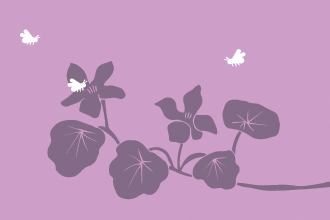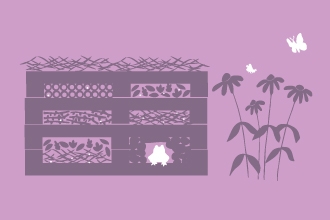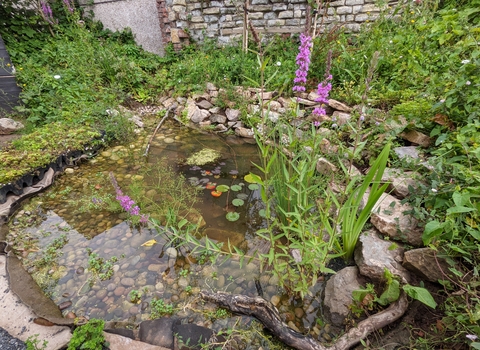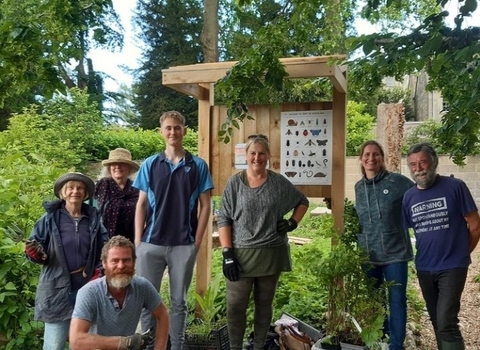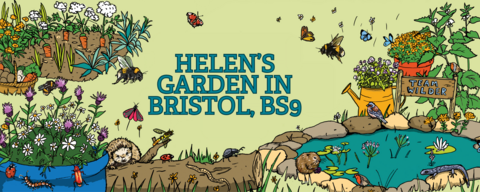
Hannah Bunn
Individual garden: Helen Mohan
Name: Helen Mohan
Category: Individual garden in the wildlife gardening competition 2023
Area: Bristol, Westbury-on-Trym, BS9
What makes your garden wildlife friendly?
Helen: Everything we do in our garden considers the potential wildlife we could attract. We have a toad house, several bird boxes including those specifically for starlings, swifts, house martens, swallows, open fronted boxes for robin and dunnock etc, a woodpecker box and several small-holed boxes for tits etc. There are three ponds all with British native plants, a swampy area, and several bird baths at height and low to the ground, and many different types of habitat, from a fern garden to shade garden, hot garden, British native wild flower garden, wood piles etc.
Parts of our lawn are left long through the season for flowers and seeds to enable the longer duration of some lifecycles. There are plenty of seeds and fruit and access point through the fences. We leave plants to flower and set seed and weed out more than we plant. We have flowers and colour in the garden at all times of the year. We don't use poisons in the garden, using barrier and physical methods if some animals become a problem, such as early in the season with slugs. We encourage a balanced garden where the wildlife looks after the wildlife so we don't have to. There is also space for wood piles and nooks and crannies for invertebrates. We don't clear us too soon leaving seed heads and other structures throughout the winter.
Tell us what you love about your garden
The garden is our sanctuary, it belongs to the local wildlife and us humans who have the honour to live here. We have many mini-gardens within the garden providing lots of different habitats. We are able to "borrow" structure from neighbouring gardens which give us a backdrop of many different trees, altogether providing a real haven for a huge variety of wildlife. A quick count as writing this has noted the 122 species of animal positively identified and that's without maintaining a detailed list. Beyond that we have many British native wildflower species, with that number growing every year. Many hours are spent just sitting, watching the garden from the house and enjoying the wildlife co-habiting with us "do it's thing"

Stephanie Chadwick
What wildlife have you seen in your garden?
In our garden we have identified 44 species of bird, 9 species of mammal identified, 14 species of butterfly, 5 large moths, 31 other notable insects, 6 different slug sand snails, 8 species of spider and 4 species of amphibian. The bird list includes an oystercatcher, a kingfisher, regular visits from sparrowhawks, mallards, grey herons, the occasional bullfinch and more recently greenfinches, house sparrows, and starlings are making a comeback - they weren't here when I moved in 12 years ago. We have soprano pipistrelle bats, pipistrelle bats and noctule bats, as well as badger, fox, yellow-necked mouse and common vole. The 14 species of butterfly include orange tip, painted lady, holly blue, small tortoiseshell, comma, brimstone, meadow brown, marble white and speckled wood. This year we have watched a spider wasp carry its prey. A highlight in the last few years was a female lesser stag beetle.
We have also had the honour of a buff-tailed bumblebee nest where I watched over 200 new queens emerge in summer 2020. Just two days ago an elephant hawk moth slept the day in our living room and headed outside at dusk. We have recently photographed and identified a boxtree moth, apparently a relative newcommer to the UK.
Helen was a finalist!
Stephanie Chadwick
Variety, variety variety! Create many different habitats with structure, flowers and seeds throughout the year and water on hand for the wildlife. Remember that not being too tidy also creates habitats and gives the wildlife a chance to use the resources that you might otherwise throw away.
There is beauty beyond the flowers and colour, so enjoy the grace of seeding grasses, the statuesque nature of seed heads and the textures of different habitats that will all bring the wildlife to you. If you invite it, it will come.
Feeling inspired?

Stephanie Chadwick
Helen has shared some wonderful tips to notice and appreciate what's in your garden beyond the flowers. Here are some ideas to recreate in your own garden or community outdoor spaces, with some extra advice from the Team Wilder Community Ecologist:
Meadow management The wildflower meadow can be sown with wildflower seeds and/or planted with plug plants. The areas should be sown in the spring or autumn (September-November). Ensure that the grass is mown very short within the area before you want to sow the seed. Collect the arisings immediately so that the nutrients don’t leach back into the soil (wildflowers grow well in low nutrient soils). Then create at least 50% bare ground by raking or using a hand scarifier.
I suggest that you have a look at the wildflower meadow mixes from a number of suppliers. The suppliers offer seed mixes for different types of environments and soils. The providers also detail suitable management techniques for the chosen seed mix.
Plug plants could be planted into the meadow area, in addition to or instead of sowing a seed mix. I recommend that you look into what species are included in the different seed mixes to give you an idea of what plug plants to buy. For example, for sunny spots, I recommend that you choose flowers such as oxeye daisy, common knapweed, purple selfheal, common toadflax, bird’s-foot trefoil and field scabious. For more shaded locations you might want to plant red campion, yarrow, garlic mustard and wild carrot. The below suppliers also have seed mixes for shaded/woodland areas that might be suitable for sowing/planting under the tree.
Grow Wilder offer native, ethically sourced seeds and wildflowers with a local origin of Bristol. Many of the wildflower seeds have been collected from Avon Wildlife trust reserves.
Yellow rattle This website below discusses the factors that influence yellow rattle – such as needing to sow in the autumn (to have cold stratification), needing to be fresh etc. The webpage includes a useful video which discusses this clearly.
Habitataid: Yellow Rattle
Slow worms I would advise against moving any slow worms from their original population. Although it is not an offence to move slow worms (only to intentionally kill, injure or trade slow worms), the moving of the slow worms may disturb the population structure and it is also uncertain whether they will be successful in the garden. I suggest that you first assess whether you have slow worms present in your garden (they may be there without you knowing!) by putting down some roof felt – you can buy this cheaply in B&Q or similar. You can cut the roof felt into small square mats and leave these in areas that might be suitable, such as longer grass which receives sunlight. Overtime, you might find slow worms basking underneath these mats!
Resources

West of England Combined Authority and Natural History Consortium
Be part of Team Wilder
Feeling inspired by this wildlife garden? Try something for yourself at home, in your community, school, business or land, no matter the size.
All actions for nature collectively add up and makes a difference for people and wildlife.
Share your actions for nature, like Helen, and motivate others to do the same.
Log your actions for nature on the map







